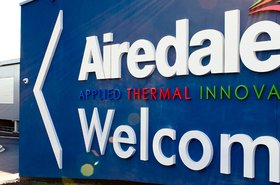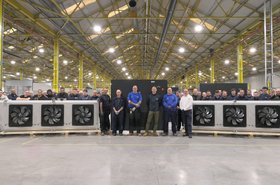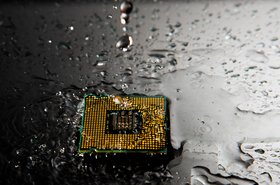Almost every touchpoint of life these days seems to revolve around artificial intelligence (AI) – from the photos we take to the TV we watch, our activity is analyzed. Our lives are constantly being quantified and used to gradually quantify, optimize, and improve the experience, and all with data centers as the unseen, beating heart.
It follows, therefore, that the data centers themselves can be improved by the employment of predictive analytics, machine learning, and other facets of AI. Marginal gains can add up to a better experience, which feeds down from the data center to the end user.
Reece Thomas is controls director at Airedale by Modine, a company with data center cooling at the heart of its operation. The solutions his team offer perfectly position Thomas to talk with DCD about the possibilities and challenges of equipping data centers with AI, through the lens of Airedale’s Facility Management System (FMS), now augmented with this technology.
Airedale’s FMS combines the functions of a Building Management System (BMS) and Power Management System (PMS), with a Data Center Infrastructure Management (DCIM) system, in a secure, single-pane-of-glass alignment, bolstered by machine learning.
“A DCIM tends to be more about white space, so where you put servers in the room, and the racks and the loadings within those racks. The FMS is a combination of your BMS and PMS, looking at all the facilities as a whole,” he explains.
Thomas is keen to emphasize the differences between these systems, especially in terms of how they relate to AI, pointing to the dangers of falling into a so-called ‘trough of disillusionment’, a term that describes a new technology that receives much attention, but perhaps doesn’t live up to the hype.
“Which in a way, is what we're seeing with AI – although everyone's talking about it, from a cooling perspective, it's not quite there yet, compared to traditional cooling methods.”
But why is AI, perhaps one of the most significant developments in computing history, at risk of falling into such a ‘trough’? Think of it like sitting at a piano for the first time, pressing the keys, and thinking you’ll be able to play. Thomas expands on this:
"Many people expect to switch AI on and have it automatically start doing things for them, but in truth, you've got to have the data to be able to train models. Any model can be trained with any data, so data center operators need to start collecting meaningful data now to be ready for the future. They must consider both the quality and quantity of the data they are recording, with a view to then analyze the data they have collected to see if it can be used to train specific models which are capable of making specific predictions.”
Machine learning in particular – a subset of AI – needs time and input to affect positive change. The hardest challenge in machine learning is the initial data collection, so you have historical data from which to work with. “Any data collected from operations is worth its weight in gold,” affirms Thomas.
Fortunately, most of the data points that are required for an FMS are ones that your systems are already collecting via sensors:
“It jumps back to the Internet of Things (IoT) hype from around five or six years ago, but now it's jumped to AI,” says Thomas. “The difference is that AI can collect all that data from IoT sensors along with other sources, tune that pipeline of data into the required output, analyze it, and draw meaningful conclusions that, when aggregated, add up to marginal gains, and in turn, a competitive advantage.”
"Although we've delivered controls, from machine level to system level – which we're very ahead of the curve in because that's our background – we're also delivering large colo and hyper-scale building monitoring systems, incorporating the new machine learning and AI tools needed to collate the data."
That’s why Airedale’s FMS acts as a data lake-house, aggregating information from multiple sensors, diagnostics, and other sources, right across the facility, or indeed multiple facilities:
“By having all the data, timestamped, in the same place, in the same format through an FMS, you can start to utilize these models better and focus on what's going on,” said Thomas, “You should have all machines visible in the same environment, every connected device in one secure ‘pane of glass’, and creating a common format for the information reduces the amount of ‘on-the-fly’ parsing that is required, which speeds up response times.“
However, in order for this to work, the data needs to be cleaner-than-clean, and that simply can’t happen on day one any more than we can sit at the keyboard and expect to play a Beethoven sonata without practicing.
Thomas tells us, “With machine learning and AI, data is king. There has to be a commitment and purposeful action towards the collation of data, and it has to be accurate. Not collecting data makes machine learning impossible, but irrelevant data will give you inaccurate predictions. It has to be controlled.
“To make accurate predictions, AI models need to be fed enough high-quality data. That’s often the challenge as it takes time and resources. Bad data generally isn’t a problem, as anomalies in supervised learning and prediction are typically rare and can be easily dealt with. In our test lab, we can create a fault, a problem, or an inefficient environment and highlight this issue in the data collected. We can then use this data to train the model, by demonstrating the types of “off-normal” data to look out for.”
In other words, if you are considering implementing an AI-augmented system in your day-to-day operations in 2026, the time to start training it is now, allowing it to learn from data in a sandbox environment before it gets put in charge of any functionality. Of course, a lot of training happens before installation:
“The good thing about these models is that we can model the data center a bit like a digital twin. You can show the impact of what you're going to do. You can model it all out, and then let the machine allow it to only do certain things because as long as your system is already efficient, it's still quietly finding those marginal gains within it.”
Thomas tells us, pointing to the “guard rails” built into such systems that avoid any imagined doomsday scenario, and instead, leverage the many benefits of AI. He points out the subtleties:
“There's a difference between controlling and optimizing. Physically turning machines on and off? Well, we do that in code now. That's not machine learning. This is AI operating in its truest and most effective form." Having reassured us of what AI won’t do, we look at what it can, in the guise of a learned friend:
“At the moment, we allow it to turn chillers and fan walls on and off. It might even be coolant distribution units (CDU) in the future. You do that based on load. You're letting a machine turn a machine off. Very few data centers do that.
“By getting the data from all around the site – ultimately, the machines could start looking to see if the power quality is bad on the main supply and move the machines over to an alternative supply to save energy. But with machine learning, historical data, and analyzing constantly over and over again, as long as you put the boundaries in the actual hardware itself, you can only do so much, so it's more of a guiding tool.”
The other thing to remember is that, if you’re opening a new facility, you’re unlikely to see significant benefits from AI predictive analytics to begin with. Any data center operator will tell you that when first opening, you would expect things to be pretty optimized already. AI is about the long game, as Thomas explains:
“Maybe there's something in a system we've been missing all along. It might be the way the pumps are being controlled, for example. But overall, the huge gains in energy will come as the facility starts to grow older, where machines and systems are not working at their design point anymore due to wear and tear and things like that. There'll be a new energy curve, a new efficiency curve.”
During the halcyon period, the AI is hard at work learning what “good” looks like, and will soon be able to spot if any “bad” has crept in.
With the Airedale team working to make its FMS the best it can be, it could be time to see if it, or a system like it, is right for you. We ask Thomas why Airedale is the right choice to support customers starting on their AI journey:
“At Airedale, we deliver huge campuses. Be it a 30-megawatt center, a 100MW campus, or everything in between. Our FMS is one system collecting and normalizing data, and keeping it in the same environment, all to the same timeframes. The information stays on site, meeting the highest security standards of both ourselves and the data center operator. That's something that we are delivering right now for some large names across the industry.
He adds, “Everyone thinks of Airedale for cooling, but we're also making waves in the FMS area, and we're developing machine learning and predictive analytics to power that. The examples I have seen from some other providers suggest their systems are not working with true AI networks, but in reality, are more of a control system.”
It’s not just that which Thomas believes sets Airedale’s solution apart: “We've got a full development team that focuses just on this. We've got delivery teams for BMS, PMS, and FMS, and then our cooling and manufacturing, which all tie nicely into that. From a technology stack, we start at the machine level, to the system level, to the building level, and then this is our holistic way to give that final element of optimization.”
Thomas points out that by working with Airedale, you can play a role in making AI systems even better, “By getting all that data in, by having a lot of the components that we fully understand because we design them, it enables us to be able to start training more of these networks and working with the operators to say, what problems do you see on your site? How is it working? Even learning about the history of a building, because not all data centers are the same.”
For more information about Airedale by Modine software and controls, or to book an online or in person CPD, please visit www.airedale.com.
More from Airedale by Modine
-

Sponsored Airedale by Modine unveils expanded capacities for coolant distribution units
CDUs are essential for colocation, hyperscale, and edge-based data center providers seeking to manage higher density IT heat loads
-

Modine scores $180m contract from new AI data center customer
Airedale systems to be delivered over the next year and a half
-

Sponsored Working together for a hybrid cooling future
How Airedale by Modine’s end-to-end vision makes tailored hybrid cooling solutions a reality

